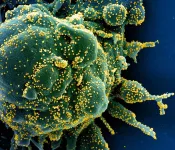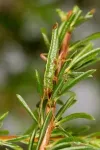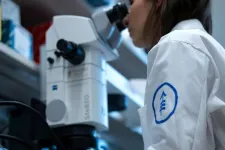(Press-News.org) LA JOLLA, CA—New research from scientists at La Jolla Institute for Immunology (LJI) suggests people who received COVID-19 vaccines and then experienced "breakthrough" infections are especially well armed against future SARS-CoV-2 infections.
By analyzing blood samples from study volunteers, the LJI researchers discovered that people who experienced symptomatic breakthrough infections develop T cells that are better at recognizing and targeting SARS-CoV-2, including the Omicron and Delta variants. The researchers describe this increased protection as an "immunity wall."
"The virus evolves, but, importantly, so does the immune system. T cells do not sit idle. Instead, they learn to recognize the parts of the virus that mutate," says LJI Professor Alessandro Sette, Dr.Biol.Sci., who co-led the Cell Reports Medicine study with LJI Professor Shane Crotty, Ph.D., and LJI Research Assistant Professor Alba Grifoni, Ph.D.
Key findings:
Study volunteers who experienced symptomatic breakthrough infections developed T cells that recognized multiple targets on the SARS-CoV-2 viral "Spike" and non-Spike epitopes.
This infection left study volunteers with T cells that were better equipped to recognize mutated regions on new SARS-CoV-2 variants.
Even asymptomatic breakthrough infections boost T cell responses, though the effect was not as significant.
Breakthrough infections also led B cells to produce cross-reactive antibodies against SARS-CoV-2. Most of these antibodies targeted the new viral variants and the original vaccine antigens.
The researchers found no evidence of harmful "T cell exhaustion" in study volunteers who had experienced repeated COVID-19 vaccinations and SARS-CoV-2 infections.
T cells gain fighting power
Many studies have shown that vaccination against SARS-CoV-2, the virus that causes COVID-19, provides people with significant immune protection against severe disease. Several LJI-led studies have shown that this immune protection is long-lasting and can even help protect the body from new viral "variants of concern."
For the new study, LJI scientists investigated exactly how breakthrough infections affect T cells and B cells. The researchers followed a large group of study volunteers who had been vaccinated against SARS-CoV-2, the virus that causes COVID-19. Over time, many of these volunteers experienced breakthrough infections. The LJI scientists followed up with these volunteers to collect new blood samples post infection.
"With this study volunteer cohort, we were in a unique position to see how the immune system looked before and after a breakthrough infection," says Grifoni.
Study co-first author and LJI Postdoctoral Researcher Alison Tarke, Ph.D., spearheaded research showing that breakthrough infections prompted T cells to expand their "repertoires." That meant the cells could recognize multiple features, or antigens, on SARS-CoV-2.
These T cells appeared to develop their broad repertoires due to a combination of vaccination and breakthrough infection. COVID-19 vaccines taught the T cells to recognize a key part of SARS-CoV-2 called the "Spike" protein. Meanwhile, SARS-CoV-2 infection prompted T cells to recognize Spike, as well as several other viral proteins.
Breakthrough infection had left these study volunteers with T cells that could recognize and target SARS-CoV-2, even if part of it was mutated.
More layers of protection
Breakthrough Omicron and Delta variant infections also prompted B cells to produce more diverse antibodies. These antibodies could target epitopes that the vaccine and the infecting SARS-CoV-2 variant had in common.
In fact, most of these new antibodies were good at attacking epitopes that the vaccine and the variants had in common. "New B cell responses that are only specific to the infecting variant, but not the vaccine, are very rare," says study co-first author and LJI Instructor Parham Ramezani-Rad, Ph.D.
The researchers uncovered another interesting trend in people with breakthrough infections. COVID-19 vaccines tend to be given in the upper arm, which means anti-SARS-CoV-2 immune cells develop far away from the upper respiratory system. SARS-CoV-2 tends to infect the upper respiratory tract first, which means there can be a delay getting the right immune cells to the scene of infection. "A breakthrough infection has the potential of adding a layer of protection on top of a vaccine," says Grifoni.
What about asymptomatic infections?
As they worked, the scientists also found markers of previous SARS-CoV-2 infection in about 30 percent of study volunteers who had never shown COVID-19 symptoms. These volunteers appeared to have contracted asymptomatic cases of COVID-19 at some point earlier in the pandemic.
"Our study suggests most people who never thought they got a breakthrough infection actually did," says Grifoni. "The majority of the population appears to be affected by a combination of vaccination and one or more breakthrough infections."
No evidence of T cell exhaustion
The new study also addresses concerns that repeated infection or COVID-19 vaccine might lead to a phenomenon called T cell exhaustion, where T cells lose their ability to target a pathogen.
The researchers discovered that breakthrough infections prompted T cells to produce more types of cytokines, signaling molecules that help fight infection. Before a breakthrough infection, T cells might produce one or two types of cytokines, Grifoni explains.
"After the breakthrough infection, the same cells produce multiple types of cytokines, making them more efficacious," says Grifoni. "Not only are our T cells not exhausted, but they are actually improving their capabilities."
The "immunity wall" does seem to have limits. Following an asymptomatic breakthrough infection, T cell abilities appeared to plateau in response to a subsequent symptomatic infection. B cells continued to produce neutralizing antibodies following subsequent breakthrough infections, but the researchers didn't see the same big "boost" to neutralizing antibody levels.
So should people continue to get SARS-CoV-2 booster vaccines? The LJI scientists point out that SARS-CoV-2 continues to evolve, and COVID-19 can still cause serious illness in immunocompromised people. Their advice is to follow all current CDC guidelines on who should receive booster vaccines.
Discovery may guide vaccine efforts
This research is also an important step toward the development of new vaccines against future SARS-CoV-2 variants and many other viruses with pandemic potential.
Ramezani-Rad says the study helps answer important questions about how breakthrough infections alter antibody responses. Going forward, he is curious how future SARS-CoV-2 variants—or new vaccine designs—might further tweak the immune system.
"Studies of local B cell responses in the upper airway—where the infection occurs—will also be informative on how B cells responses are induced, particularly after breakthrough infection," says Ramezani-Rad.
Sette and Grifoni are focused on how to train T cells to recognize many types of coronaviruses at once. Their research is critical for developing a "pan-coronavirus" vaccine.
In a 2023 study, their laboratories worked with scientists at the University of Genoa to show that some T cells can recognize multiple coronaviruses at once. This new study shows them how breakthrough infections can shape T cell responses to fight novel SARS-CoV-2 variants.
"We're very interested to see if this phenomenon could be exploited in general to prepare against other potential pandemic threats," says Sette. "This is a step in a journey to help us protect against viral infections and potential pandemics."
Additional authors of the study, "SARS-CoV-2 breakthrough infections enhance T cell response magnitude, breadth, and epitope repertoire," include Tertuliano Alves Pereira Neto, Yeji Lee, Vanessa Silva-Moraes, Benjamin Goodwin, Nathaniel Bloom, Leila Siddiqui, Liliana Avalos, April Frazier, Zeli Zhang, Ricardo da Silva Antunes, and Jennifer Dan.
This study was supported by the National Institutes of Health (NIH; T32AI125179), the NIH National Institute of Allergy and Infectious Diseases (75N93021C00016, 75N9301900065, and AI142742.)
DOI: 10.1016/j.xcrm.2024.101583
About La Jolla Institute
The La Jolla Institute for Immunology is dedicated to understanding the intricacies and power of the immune system so that we may apply that knowledge to promote human health and prevent a wide range of diseases. Since its founding in 1988 as an independent, nonprofit research organization, the Institute has made numerous advances leading toward its goal: life without disease. Visit lji.org for more information.
END
How COVID-19 'breakthrough' infections alter your immune cells
Repeated vaccination and infection leads T cells and B cells to build an "immunity wall"
2024-05-24
ELSE PRESS RELEASES FROM THIS DATE:
Virginia Tech entomologist sheds light on 250-year-old mystery of the German cockroach
2024-05-24
May 24, 2024 --
A team of international scientists, including Virginia Tech entomologist Warren Booth, have solved the 250-year-old origin puzzle of the most prevalent indoor urban pest insect on the planet: the German cockroach.
The team's research findings, representing the genomic analyses of over 280 specimens from 17 countries and six continents, show that this species evolved some 2,100 years ago from an outside species in Asia and were released this week in the Proceedings of the National Academy of Sciences journal.
One ...
Advancing skin science: explore Skin Ageing & Challenges 2024 Strategic Topics in Malta this November
2024-05-24
Get introduced to the latest advances in skin research at the 15th International Conference on Skin Ageing & Challenges 2024 on November 5-6 at Corinthia Palace in Malta.
Skin Ageing & Challenges 2024 will cover the hottest topics shaping the future of skin aging and rejuvenation.
How will Skin Ageing & Challenges 2024 Expand Your Knowledge?
Senolytics: Exploring new ways to fight cell aging with innovative senolytic treatments.
Extracellular Vesicles: Discovering the potential of EVs for skin regeneration and repair.
Skin Microbiota / Mitochondria Transplantation: Introducing approaches to harness the power of microbiome and mitochondrial transplantation ...
Controlling water, transforming greenhouse gases
2024-05-24
Carbon dioxide is the greenhouse gas, singlehandedly responsible for 78% of the change in energy balance in Earth's atmosphere between 1990 and 2022.
A byproduct of burning fossil fuels, carbon dioxide enters the atmosphere from car exhaust and coal-fired power plants. Even some renewable energy resources produce a small amount of carbon dioxide, although at a tiny fraction of the amount coal and natural gas create.
At its core, this molecule is just an arrangement of one carbon and two oxygen atoms that can be reorganized through a ...
MSK Research Highlights, May 24, 2024
2024-05-24
New research from Memorial Sloan Kettering Cancer Center (MSK) investigates a promising approach against diabetic retinopathy and finds patients with early-onset colorectal cancer likely don’t need more frequent surveillance colonoscopies.
Anti-ceramide immunotherapy promising against diabetic retinopathy, animal studies suggest
Diabetic retinopathy is a condition that affects blood vessels in people with diabetes and can cause blindness. Now a new study from a team at MSK, Michigan State University, and the University of Oklahoma Health Sciences Center shows that diabetic retinopathy can be considered a “ceramidopathy” — which ...
ASCO: Large precision oncology study identifies differences in prostate cancer genomics among a racially and ethnically diverse cohort of U.S. veterans
2024-05-24
FINDINGS
A new study led by a UCLA-VA collaborative team looking at the landscape of genomic alterations in more than 5,000 veterans with metastatic prostate cancer uncovered differences in the genomic makeup of cancer cells that were associated with race and ethnicity.
Although the team found that a similar set of cancer-related genes were altered in both non-Hispanic Black and non-Hispanic white veterans, the frequencies that these alterations were observed at varied significantly ...
ASCO: Combination therapy significantly improves outcomes for patients with metastatic colorectal cancer
2024-05-24
FINDINGS
A study led by UCLA Health Jonsson Comprehensive Cancer Center researchers found that using a combination of experimental immunotherapy drugs with chemotherapy significantly improves progression-free survival and overall survival for patients with metastatic colorectal cancer who have previously undergone standard chemotherapy treatment when compared to those who received the targeted therapy regorafenib alone.
The median progression-free survival, which is the amount of time during and after treatment when the cancer does not worsen or progress, with the combination treatment was 6.2 months compared to 2.1 months for those ...
Euclid space mission releases first scientific results and new images of the cosmos
2024-05-24
European space mission Euclid has released early scientific papers based on observations made by the space telescope, along with five new astronomical images of the Universe, as the project sets about unravelling the secrets of the cosmos.
The new images are part of Euclid’s Early Release Observations (EROs) and accompany the mission’s first scientific data and 10 forthcoming science papers. Their publication comes less than a year after the space telescope’s launch and some six months after it returned its first full-colour ...
Sociodemographic heterogeneity in the associations of social isolation with mortality
2024-05-24
About The Study: Social isolation was associated with increased risks of all-cause, cardiovascular diseases, and malignant neoplasm mortality, with associations varying across populations. This study fills an important gap in research on social isolation, emphasizing its varied associations across demographic and socioeconomic groups.
Corresponding Author: To contact the corresponding author, Atsushi Nakagomi, M.D., Ph.D., email anakagomi0211@gmail.com.
To access the embargoed study: Visit our For The Media website at this link https://media.jamanetwork.com/
(doi:10.1001/jamanetworkopen.2024.13132)
Editor’s Note: Please ...
COVID-19 admission rates and changes in care quality in us hospitals
2024-05-24
About The Study: In this cross-sectional study, COVID-19 surges were associated with declines in hospital quality, highlighting the importance of identifying and implementing strategies to maintain care quality during periods of high hospital use.
Corresponding Author: To contact the corresponding author, Giacomo Meille, Ph.D., email giacomo.meille@ahrq.hhs.gov.
To access the embargoed study: Visit our For The Media website at this link https://media.jamanetwork.com/
(doi:10.1001/jamanetworkopen.2024.13127)
Editor’s Note: Please see the article for additional information, ...
Preterm and early-term delivery after heat waves in 50 US metropolitan areas
2024-05-24
About The Study: Preterm and early-term birth rates increased after heat waves, particularly among socioeconomically disadvantaged subgroups in this cohort study. Extreme heat events have implications for perinatal health.
Corresponding Author: To contact the corresponding author, Lyndsey A. Darrow, Ph.D., email ldarrow@unr.edu.
To access the embargoed study: Visit our For The Media website at this link https://media.jamanetwork.com/
(doi:10.1001/jamanetworkopen.2024.12055)
Editor’s Note: Please see the article for additional information, including other authors, author contributions and ...
LAST 30 PRESS RELEASES:
National poll: Less than half of parents say swearing is never OK for kids
Decades of suffering: Long-term mental health outcomes of Kurdish chemical gas attacks
Interactional dynamics of self-assessment and advice in peer reflection on microteaching
When aging affects the young: Revealing the weight of caregiving on teenagers
Can Canada’s health systems handle increased demand during FIFA World Cup?
Autistic and non-autistic faces may “speak a different language” when expressing emotion
No clear evidence that cannabis-based medicines relieve chronic nerve pain
Pioneering second-order nonlinear vibrational nanoscopy for interfacial molecular systems beyond the diffraction limit
Bottleneck in hydrogen distribution jeopardises billions in clean energy
Lung cancer death rates among women in Europe are finally levelling off
Scientists trace microplastics in fertilizer from fields to the beach
The Lancet Obstetrics, Gynecology, & Women’s Health: Taking paracetamol during pregnancy does not increase risk of autism, ADHD or intellectual disabilities, confirms new gold-standard evidence review
Taking paracetamol during pregnancy does not increase risk of autism, ADHD or intellectual disabilities
Harm reduction vending machines in New York State expand access to overdose treatment and drug test strips, UB studies confirm
University of Phoenix releases white paper on Credit for Prior Learning as a catalyst for internal mobility and retention
Canada losing track of salmon health as climate and industrial threats mount
Molecular sieve-confined Pt-FeOx catalysts achieve highly efficient reversible hydrogen cycle of methylcyclohexane-toluene
Investment in farm productivity tools key to reducing greenhouse gas
New review highlights electrochemical pathways to recover uranium from wastewater and seawater
Hidden pollutants in shale gas development raise environmental concerns, new review finds
Discarded cigarette butts transformed into high performance energy storage materials
Researchers highlight role of alternative RNA splicing in schizophrenia
NTU Singapore scientists find new way to disarm antibiotic-resistant bacteria and restore healing in chronic wounds
Research suggests nationwide racial bias in media reporting on gun violence
Revealing the cell’s nanocourier at work
Health impacts of nursing home staffing
Public views about opioid overdose and people with opioid use disorder
Age-related changes in sperm DNA may play a role in autism risk
Ambitious model fails to explain near-death experiences, experts say
Multifaceted effects of inward foreign direct investment on new venture creation
[Press-News.org] How COVID-19 'breakthrough' infections alter your immune cellsRepeated vaccination and infection leads T cells and B cells to build an "immunity wall"







